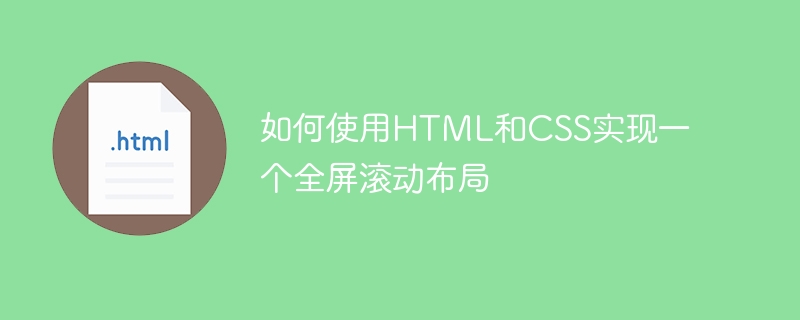

How to use HTML and CSS to implement a full-screen scrolling layout requires specific code examples
With the development of the Internet, page design pays more and more attention to user experience. Full-screen scrolling layout is a common design method that can make the page more attractive and provide a smooth user navigation experience. If you want to learn how to implement a full-screen scrolling layout using HTML and CSS, this article will provide you with specific code examples and implementation steps.
Before you start, you need to know the basics of HTML and CSS, and a little knowledge of JavaScript. If you already have these basics, then we can start implementing a full-screen scrolling layout.
First, we need to create an HTML file and define some basic structures. The following is a simple HTML template:
<!DOCTYPE html>
<html>
<head>
<title>全屏滚动布局</title>
<link rel="stylesheet" type="text/css" href="styles.css">
<script src="script.js"></script>
</head>
<body>
<div class="scroll-container">
<div class="section section1">
<h1>第一屏</h1>
</div>
<div class="section section2">
<h1>第二屏</h1>
</div>
<div class="section section3">
<h1>第三屏</h1>
</div>
</div>
</body>
</html>In the above code, we create a scroll-container container, which contains three section# with different content ##part. In each section, we can customize various contents, such as text, pictures, etc.
/* 设置容器的高度和宽度 */
.scroll-container {
width: 100%;
height: 100vh;
overflow: hidden;
position: relative;
}
/* 设置每个section的高度和宽度 */
.section {
width: 100%;
height: 100vh;
position: relative;
/* 这里可以设置每个section的样式 */
}
/* 设置每个section的内容居中 */
.section h1 {
text-align: center;
position: absolute;
top: 50%;
left: 50%;
transform: translate(-50%, -50%);
}100vh), And hides content outside the container. Then, we set the width to 100% and the height to the height of the viewport for each section, thus ensuring that each section can fill the entire page. Finally, we used some simple styling to center the content within each section.
sections based on the scrolling position. The following is a simple JavaScript example:
document.addEventListener('DOMContentLoaded', function(event) {
// 获取所有的section元素
var sections = document.getElementsByClassName('section');
// 设置当前显示的section索引值
var currentSectionIndex = 0;
// 监听滚动事件
window.addEventListener('scroll', function(event) {
// 计算滚动位置
var scrollTop = window.pageYOffset || document.documentElement.scrollTop;
// 根据滚动位置切换section
if (scrollTop < sections[1].offsetTop) {
currentSectionIndex = 0;
} else if (scrollTop < sections[2].offsetTop) {
currentSectionIndex = 1;
} else {
currentSectionIndex = 2;
}
// 根据当前显示的section索引值来更新样式
for (var i = 0; i < sections.length; i++) {
if (i === currentSectionIndex) {
sections[i].classList.add('active');
} else {
sections[i].classList.remove('active');
}
}
});
});sections based on the scrolling position. We determine the positional relationship between the scroll position and each section by obtaining the offsetTop attribute of each section element, and update the currently displayed section style.
index.html, styles.css and # respectively. ##script.js. Then, you can open the index.html file in your browser to view the implemented full-screen scrolling layout effect. Summary:
section
according to your own needs, and use JavaScript to handle scroll events to switch different section. I hope this article will be helpful to your study!
The above is the detailed content of How to implement a full-screen scrolling layout using HTML and CSS. For more information, please follow other related articles on the PHP Chinese website!